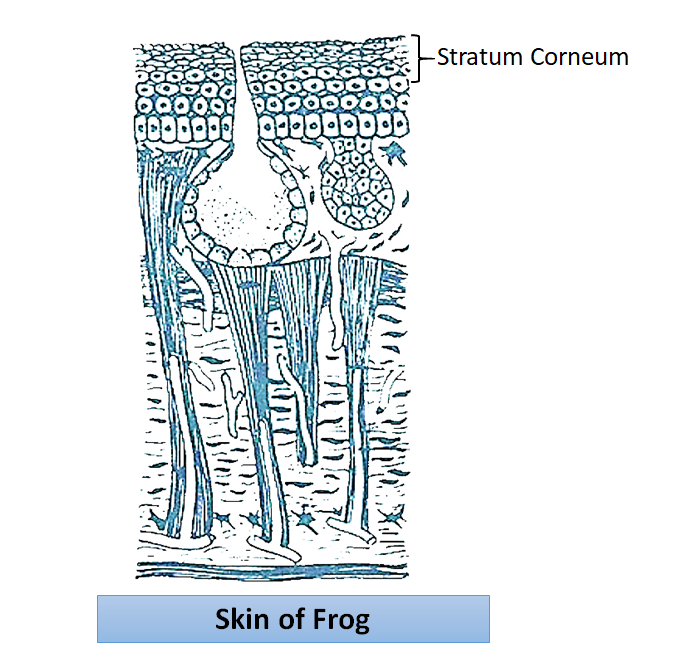
Outer layer of skin that frog casts off is composed of
(a) Simple squamous epithelium
(b) Tessellated epithelium
(c) Ciliated epithelium
(d) Cuboidal epithelium
Answer
488.1k+ views
Hint: A layer of fat cells that are arranged in a single layer that helps the small particles and molecules to enter inside and its primary function is protection against harmful germs and substances and is the outermost layer.
Complete answer:
The outermost layer of the skin of the frog casts is composed of the simple squamous epithelium. It is sometimes also called Stratum corneum. It is made up of square- like flattened cells that are arranged in a single layer with the nucleus inside it. It acts as a protective covering of the body from the outside world.
- The cells of the squamous epithelium are attached to the basal membrane of the epithelium that may be two or three- layered.
- It is permeable to small particles and substances that provide nutrition to the cells.
- The particles passed through the epithelium by the process of diffusion and filtration.
- This type of epithelium is also found in the lining of the inner organs like alveoli, lungs, capillaries, etc.
- The layer of this epithelium appears like tiles, so it is also called pavement epithelium.
- The epithelium constitutes a layer of thin cells that are keratinized and appears horn- like.
- It is usually made up of dead cells that are cast off at the time of molting.
- This layer is composed of three main substances that include: ceramides, cholesterol, and fatty acids.

So, the correct answer is ‘Simple squamous epithelium’.
Note: The keratin present in the stratum corneum is responsible for providing the hydration to the skin and prevents the process of evaporation that leads to the loss of water from the skin making it dry. It helps the skin to remain at its position and stretches it back by absorbing water from the surroundings. This layer is permanent in frogs but during molting, it is shed off and is replaced by a more rigid layer composed of beta keratin.
Complete answer:
The outermost layer of the skin of the frog casts is composed of the simple squamous epithelium. It is sometimes also called Stratum corneum. It is made up of square- like flattened cells that are arranged in a single layer with the nucleus inside it. It acts as a protective covering of the body from the outside world.
- The cells of the squamous epithelium are attached to the basal membrane of the epithelium that may be two or three- layered.
- It is permeable to small particles and substances that provide nutrition to the cells.
- The particles passed through the epithelium by the process of diffusion and filtration.
- This type of epithelium is also found in the lining of the inner organs like alveoli, lungs, capillaries, etc.
- The layer of this epithelium appears like tiles, so it is also called pavement epithelium.
- The epithelium constitutes a layer of thin cells that are keratinized and appears horn- like.
- It is usually made up of dead cells that are cast off at the time of molting.
- This layer is composed of three main substances that include: ceramides, cholesterol, and fatty acids.

So, the correct answer is ‘Simple squamous epithelium’.
Note: The keratin present in the stratum corneum is responsible for providing the hydration to the skin and prevents the process of evaporation that leads to the loss of water from the skin making it dry. It helps the skin to remain at its position and stretches it back by absorbing water from the surroundings. This layer is permanent in frogs but during molting, it is shed off and is replaced by a more rigid layer composed of beta keratin.
Recently Updated Pages
The correct geometry and hybridization for XeF4 are class 11 chemistry CBSE

Water softening by Clarks process uses ACalcium bicarbonate class 11 chemistry CBSE

With reference to graphite and diamond which of the class 11 chemistry CBSE

A certain household has consumed 250 units of energy class 11 physics CBSE

The lightest metal known is A beryllium B lithium C class 11 chemistry CBSE

What is the formula mass of the iodine molecule class 11 chemistry CBSE

Trending doubts
State the laws of reflection of light

Arrange Water ethanol and phenol in increasing order class 11 chemistry CBSE

One Metric ton is equal to kg A 10000 B 1000 C 100 class 11 physics CBSE

Difference Between Prokaryotic Cells and Eukaryotic Cells

A mixture of o nitrophenol and p nitrophenol can be class 11 chemistry CBSE

How do I convert ms to kmh Give an example class 11 physics CBSE




